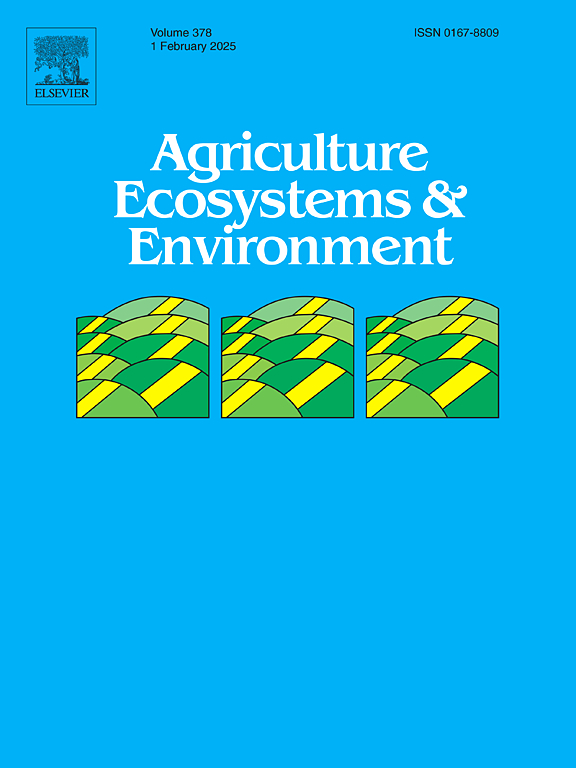冬夏作物轮作休耕期土壤CO2排放:长期田间试验中耕作、氮肥和杂草生长的影响
IF 6
1区 农林科学
Q1 AGRICULTURE, MULTIDISCIPLINARY
引用次数: 0
摘要
土壤呼吸是碳循环的一个关键组成部分,但在休耕期,特别是在地中海种植系统中,对土壤呼吸的研究仍然不足,休耕期可以超过9个月。随着碳信用市场的出现,全年准确量化二氧化碳排放量变得越来越重要。本研究评估了长期常规耕作(CT)和免耕作(NT)两种不同耕作管理下(0和180 kg N ha−1 yr−1)土壤呼吸及其非生物和生物驱动因素,如土壤温度和含水量、杂草生物量和组成。在硬粒小麦收获和玉米播种之间的两个休耕期(2022-2023和2023-2024)进行了监测。土壤温度和含水量符合典型的地中海趋势,夏季高温峰值,冬季湿度较高;在不施肥的情况下,NT地块的平均气温和冬季土壤湿度显著高于CT。土壤CO2排放量在冬季低且相似,但在温暖季节有所差异。在2022-23年,NT的排放量明显高于CT(高达+65 %),而在2023-24年,只有NT0超过CT180(+48 %)。温室气体排放量与温度呈微弱正相关,与湿度呈负相关,特别是在北纬地区。以禾科植物为主的土壤覆盖呈季节性波动,在北纬地区持续增加,物种组成差异显著。这些结果强调了休耕期排放在碳预算中的相关性以及自然植被在碳动态中的潜在作用。将这些见解纳入碳农业框架对于提高气候相关农业政策的准确性和完整性至关重要。本文章由计算机程序翻译,如有差异,请以英文原文为准。
Soil CO2 emissions during the winter–summer crop rotation fallow period: Influence of tillage, nitrogen fertilization, and weed growth in a long-term field trial
Soil respiration is a key component of the carbon cycle, yet it remains understudied during fallow periods, particularly in Mediterranean cropping systems where fallows can exceed nine months. As the carbon credit market emerges, accurately quantifying CO2 emissions year-round has become increasingly important. This study assessed soil respiration and its abiotic and biotic drivers, such as soil temperature and water content, weed biomass and composition, under two different tillage management, long-term conventional tillage (CT) and no-tillage (NT), combined with two nitrogen levels (0 and 180 kg N ha−1 yr−1). Monitoring was conducted during two fallow periods (2022–2023 and 2023–2024) between durum wheat harvest and maize sowing. Soil temperature and water content followed typical Mediterranean trends, with summer heat peaks and higher winter moisture; NT plots had significantly higher average temperatures and winter soil moisture than CT, regardless of fertilization. Soil CO2 emissions were low and similar across treatments in winter but diverged in warmer seasons. In 2022–23, NT showed significantly higher emissions than CT (up to +65 %), while in 2023–24, only NT0 exceeded CT180 (+48 %). Emissions were positively correlated, although weakly, with temperature and negatively with moisture, especially under NT. Soil cover, dominated by Poaceae, fluctuated seasonally and was consistently greater in NT, with notable differences in species composition. These results emphasize the relevance of fallow-period emissions in carbon budgeting and the potential role of spontaneous vegetation in carbon dynamics. Incorporating such insights into carbon farming frameworks will be essential for improving the accuracy and integrity of climate-related agricultural policies.
求助全文
通过发布文献求助,成功后即可免费获取论文全文。
去求助
来源期刊

Agriculture, Ecosystems & Environment
环境科学-环境科学
CiteScore
11.70
自引率
9.10%
发文量
392
审稿时长
26 days
期刊介绍:
Agriculture, Ecosystems and Environment publishes scientific articles dealing with the interface between agroecosystems and the natural environment, specifically how agriculture influences the environment and how changes in that environment impact agroecosystems. Preference is given to papers from experimental and observational research at the field, system or landscape level, from studies that enhance our understanding of processes using data-based biophysical modelling, and papers that bridge scientific disciplines and integrate knowledge. All papers should be placed in an international or wide comparative context.
 求助内容:
求助内容: 应助结果提醒方式:
应助结果提醒方式:


